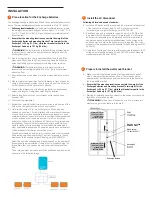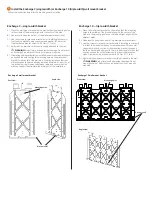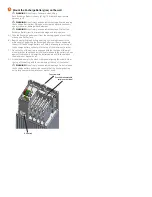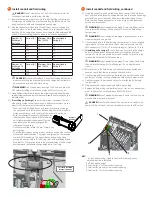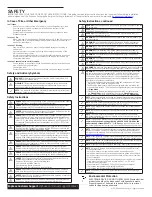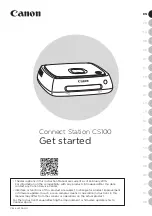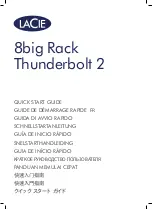
PREPARATION
A ) Inspect the packaging and the Encharge Battery(ies) for damage, such
as cracks, dents, or leaking electrolyte.
Do not install or use the Encharge
Battery(ies) if it has been damaged in any way
. If damaged, contact your
distributor for replacement.
B ) Ensure that your kit includes the following Encharge components:
•
The
Encharge 10
includes three batteries and two interunit raceways,
an Encharge 10 triple-width cover, and a triple-width mounting bracket.
•
The
Encharge 3
includes one battery, and single-width cover with
mounting bracket.
NOTE
: Check the “Must Energize By” label on the shipping box to verify
that the Encharge Battery(ies) will be installed by the date shown. If the
date has passed, contact your distributor for replacement.
*
WARNING
: Risk of injury. Take care when lifting. The Encharge
Battery unit is heavy (47 kg/ 104 lbs) and requires two persons to lift.
C ) Ensure you have the following
required Enphase items for backup systems
:
•
An Enphase Enpower smart switch with microgrid interconnect device
(MID) functionality and an Enphase IQ Combiner.
•
The Enphase Encharge system requires an Internet connection
through the IQ Envoy in the IQ Combiner. Failure to maintain an
Internet connection may have an impact on the warranty. See
enphase.com/warranty
for full terms.
•
Wireless USB Adapter (COMMS-KIT-01) to be installed at Envoy for
communications with Encharge and Enpower. Includes USB cable for
connection to IQ Envoy / IQ Combiner and allows redundant wireless
communication with Encharge and Enpower.
D ) Make sure you also have the following
required items
:
•
Mounting location that is structurally suited to bearing the weight of
the Encharge Battery(ies). Total weight for the Encharge 3 is 53 kg
(117 lbs), while the three battery units in the Encharge 10 add up to
157 kg (346 lbs). The wall must contain blocked studs that can bear
the battery weight or can be of masonry or other suitable structure.
•
Tools: conduit (with fittings and fitting tools), drill, 5/32 inch pilot bit
(or metric equivalent), screwdriver, socket wrench, torque wrench,
level, wire stripper, and stud finder if installing on studs.
•
Fasteners for wall mount bracket. Check with a structural engineer and
local standards for requirements.:
Three #8 lag bolts or screws, 7.6 cm (3 inches) long (depending on
attachment wall), for each single-wide wall-mount bracket.
Nine #8 lag bolts or screws, 7.6 cm (3 inches) long (depending on
attachment wall), for each triple-wide wall-mount bracket.
•
Washers for use between fastener heads and wall-mount bracket.
•
Copper conductors: No. 12 - 8 AWG
(11mm/7/16 inch strip length)
copper conductors (rated at 75° C or 90° C) for terminals.
•
Conduit fittings: 3/4 inch (left side) and 1/2 inch (right side) hubs are
required for all installations, and NEMA Type 3 conduit fittings (hubs)
are needed when installing out of doors (one for each used conduit
opening). Also needed are conduit plugs to close unused conduit
openings and conduit grounding nuts.
•
Over current protection: The overcurrent protection in Encharge is not branch
circuit overcurrent protection and cannot be relied upon for that purpose.
The branch circuit overcurrent protection is located in Enpower or, when
combining , in a separate combiner. See the Enphase Enpower Quick Install
Guide for more information.
•
Personal protective equipment (PPE) for handling lithium batteries as
required by local safety standards.
E ) Verify that main service is 120/240 VAC, and not 208/120 VAC. Encharge
batteries cannot be installed where L1 to L2 measures 208 VAC.
F ) Install the PV system and the IQ Combiner as directed by the Enphase
installation manuals.
G ) To record the installation of the Encharge Battery(ies), scan or remove the
serial number label for each battery and add it to the respective location
on a paper installation map. You will scan this map later using Enphase
Installer Toolkit™ and your mobile device. You can find an example
installation map at the back of any Enphase Microinverter manual.
Self consumption, no Enpower smart
switch.
The preferred configuration
when adding battery storage and PV
for self-consumption in a grid-tied
application with no option for backup
during outages. PV and Encharge will
not operate when the grid is unavailable.
Partial home backup with main
load panel as service entrance
and PV combiner connected to
sub-panel.
This is the preferred
connection configuration for partial
home backup using a subpanel
when the PV circuit breaker size is
more than 80A. The space available
in Enpower for combiner (solar)
connection is left vacant.



